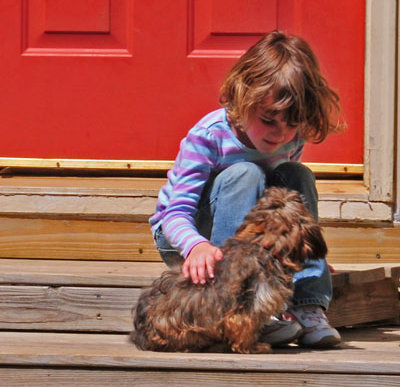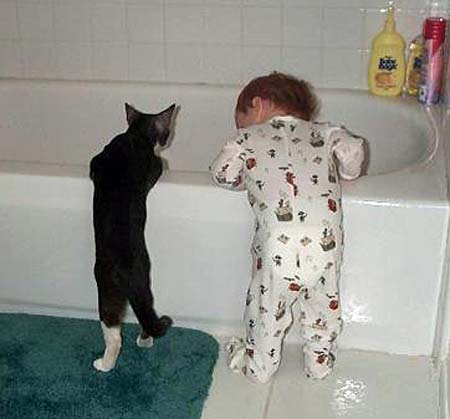 Comments and articles that mention the role of the human-animal bond in the COVID-19 era often present a highly biased human view of the companion animal’s function. Many position these animals as a source of on-demand comfort, amusement, or distraction for the sometimes stressed and fearful people who hunker down in their homes waiting for the coronavirus storm to pass. To them—and many others—the bond’s quality rests on the animal’s ability to fulfill their humans’ needs. The greater the animal’s ability to do this, the greater the human-animal bond.
Comments and articles that mention the role of the human-animal bond in the COVID-19 era often present a highly biased human view of the companion animal’s function. Many position these animals as a source of on-demand comfort, amusement, or distraction for the sometimes stressed and fearful people who hunker down in their homes waiting for the coronavirus storm to pass. To them—and many others—the bond’s quality rests on the animal’s ability to fulfill their humans’ needs. The greater the animal’s ability to do this, the greater the human-animal bond.
That this anthropocentric view of the bond becomes more prevalent in times of human turbulence isn’t surprising. It’s normal for animals of many species to go into me-first mode at such times. The one exception are those in offspring-protective parental mode. These individuals somehow summon the wherewithal to take care of their offspring first—or die trying. You can find people in both categories when it comes to their animals.
What happens to the animal half of the bond in anthropocentric relationships during times of upheaval, such as those related to the current pandemic? While we may like to think that having us around much more is an answer to their prayers, that may not be the case. Consider the matter of sleep, a state of being that plays a crucial role in animal as well as human physical and mental health and well-being. On average, dogs sleep 12-14 hours/day. But puppies and older dogs, and also dogs of any age in learning mode processing new information need more sleep too.
Dogs trying to cope with all the changes associated with their people home all the time may need to learn a great deal very fast. Stressed animals also need more sleep because the quality of the sleep they get may be low. Cats, on the other hand, normally need an average of 12-14 hours/day; but 20 hours/day isn’t unusual in some circumstances. Add processing and learning all they need to cope with their people banging around the house, let alone ranting about the news, might make some cats long to disappear so they can sleep so they could do this.
Our anthropocentric brains also may want to believe that our dogs and cats sleep soundly any time they do. But that may not be the case. Some of them normally may sleep while we work or engage in activities outside the home because they spend their nights patrolling the house to protect us and themselves. In these situation, sleeping in our absence may be the only time these animals can get the deep restorative sleep they need for mental and physical health.
If we’re home more now, let alone banging around the house or throwing hissy fits or plunging into depression triggered by media reports, our pets’ feelings for us may not be all-positive. Ditto if we engaged in comfort eating and share those questionable foods with our pets. Then they wind up quality-sleep-deprived with queasy stomachs. Meanwhile our cats may want to revert to their more deeply entrenched solitary mode and reject our self-serving food offerings until they feel comfortable in this new human-animal behavioral environment.
On the other hand, suppose we decide to hold it together for the sake of the pets. Suppose we decide to eat healthy, get more exercise, and listen to music and read books we love more often. What if we decide to go to bed and get up at our normal times and find productive projects to engage us within our confined circumstances. Like cleaning closets, organizing files or all those photos (!) on the laptop or other digital devices, calling or writing to people we’ve meant to phone or write to for ages but never had the time. Projects that give us a sense of fulfillment, and relieve the pets from having to fulfill our emotional needs and get some quality sleep instead. How could that change our perception of the bonds we form with the animals in our lives?
A friend sent me a link to a wonderful interview with Ren Hurst, long-time horse rider, trader, trainer, and author of Riding on the Power of Others about how her bond with horses evolved and changed dramatically over time. She described the evolution of a unilateral human emotion-based equine bond into a bi-lateral one similar to the one encountered by mathematician and language researcher Gertrude Hendrix. I was so taken by Hendrix’s conclusions that I delved into the ramifications of these in a commentary entitled Horses, Dogs, Learning, Serendipity and Motivation.
Both of these people described their discovery of a more transcendent human-animal bond than the anthropocentric one their training experience primed them to create. Both described how they literally had to get out of their own mental and emotional way first in order to experience this new kind of communion with the animal. Both of them described what a life-changing event this was for them and the horses with whom they shared this new kind of bond.
 How many of us have such bonds with our dogs and cats? Some days it seems like I’ve spent my whole life grappling with the schizophrenic role emotions play in the human-companion animal bond. On the one hand, some of the most anthropocentric human-animal bonds I’ve encountered have been driven strictly by human emotions and needs. The majority of these involved dogs and cats and made me want to weep . On the other hand, some of the most transcendent bonds involved farm and food animals and their caregivers. You know, those people many ardent dog- and cat-lovers like to look down their noses at. Those farm and ranch dwellers spoke of an inexplicable connection, a sense of peace and oneness they felt when they walked through the barn last thing at night after all their animals were tended, or when they watched or worked near their herds or flocks in the field: a shared message that all was well in their shared worlds.
How many of us have such bonds with our dogs and cats? Some days it seems like I’ve spent my whole life grappling with the schizophrenic role emotions play in the human-companion animal bond. On the one hand, some of the most anthropocentric human-animal bonds I’ve encountered have been driven strictly by human emotions and needs. The majority of these involved dogs and cats and made me want to weep . On the other hand, some of the most transcendent bonds involved farm and food animals and their caregivers. You know, those people many ardent dog- and cat-lovers like to look down their noses at. Those farm and ranch dwellers spoke of an inexplicable connection, a sense of peace and oneness they felt when they walked through the barn last thing at night after all their animals were tended, or when they watched or worked near their herds or flocks in the field: a shared message that all was well in their shared worlds.
As we hunker down in our houses, condos, and apartments, how often do such moments occur with our cats and dogs? Probably not nearly as often because we think it’s more mature focus on what we consider matters of greater consequence instead. Or perhaps we feel so bored or depressed we don’t notice anything except how bored and depressed we are.
I had a lot of trouble finding photos that would illustrate the kind of transcendent human-companion animal bond described above. The majority of photos I looked involving dogs were obviously posed and more often than not showed dogs responding to some command. The photographer was more interested in the dog doing rather than “just” being in the company of a person. As I became increasingly frustrated, I recalled a question asked at an early bond meeting: At what age does awareness of the human-animal bond occur in humans? The answer given by one of the early pioneers in human-animal bond observations was so obvious, I couldn’t believe I’d missed it: We’re born with it, but what we choose to do with that awareness is a choice.
That memory created a light bulb moment for me regarding where to find the best illustrations of human-companion animal bond in its purest form. I’d find it in those spontaneous shared moments between the youngest humans, dogs, and cats. It’s possible that some of our animals could be trying to re-connect with us more anthropocentric grown-ups in this age of COVID-19. The question is whether we choose to breach any gap we’ve created.
You could definitely see your enthusiasm in the work you write. The world hopes for even more passionate writers like you who aren’t afraid to say how they believe. Always follow your heart.